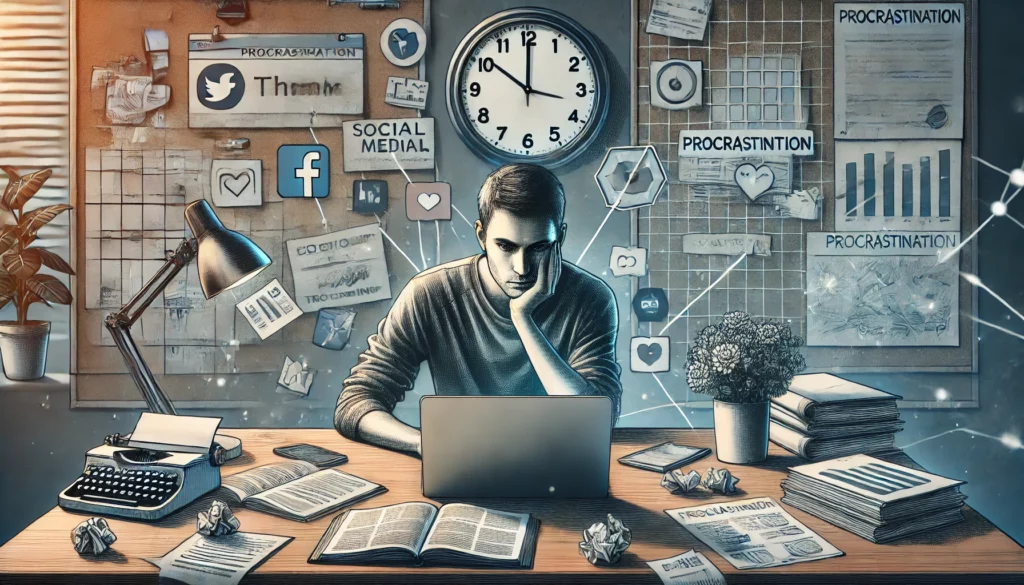Procrastination is something we’ve all experienced. You know you need to start a task—maybe an assignment, a presentation, or even just answering emails—but instead, you find yourself watching another video, scrolling endlessly, or organizing your desk for the third time today.
The worst part? You know delaying the task will only make it harder later, yet you still can’t seem to stop. Why does this happen?
This article will help you understand the true causes of procrastination, why it’s not about laziness, and how you can break the cycle with practical, science-based strategies.
Understanding Procrastination: It’s Not About Laziness
Contrary to what most people believe, procrastination is not simply a matter of being lazy. It’s more closely linked to emotional regulation, mental fatigue, fear of failure, and an internal battle between brain systems.
Let’s clarify what procrastination really is—and what it’s not:
| ❌ Procrastination Is NOT | ✅ Procrastination IS |
|---|---|
| A lack of ambition or drive | A way to avoid discomfort and emotional tension |
| Poor time management alone | A struggle to regulate emotions effectively |
| A sign of low intelligence | A common psychological response to pressure |
📌 Example: You need to write a report, but instead, you binge-watch a series. It’s not that you’re lazy—you’re likely trying to avoid the discomfort of writing or fearing the result won’t be good enough.
Why Do We Procrastinate? The Science Behind It
The brain is constantly weighing short-term comfort against long-term benefit. This inner conflict is primarily driven by two key regions:
- Prefrontal Cortex: Responsible for planning, focus, and decision-making.
- Limbic System: Driven by pleasure, it seeks instant gratification and avoids pain or discomfort.
When a task feels boring, difficult, or emotionally uncomfortable, the limbic system overrides the prefrontal cortex. This leads you to choose a more pleasurable activity—like watching YouTube—over a more important one—like finishing your assignment.
Common Triggers That Lead to Procrastination
Here’s a closer look at the specific psychological triggers behind procrastination:
| Trigger | How It Leads to Procrastination |
|---|---|
| Perfectionism | Fear of making mistakes causes delay |
| Task Overwhelm | The project seems too big to even start |
| Lack of reward | No immediate benefit makes it feel pointless |
| Distractions | Easy access to social media kills momentum |
| Low energy | Fatigue makes effort feel harder than it is |
📌 Real-world example: You’re supposed to prepare a presentation, but it feels so overwhelming that instead, you convince yourself to “start tomorrow” and spend the evening watching TikToks.
Types of Procrastinators: Which One Are You?
Not everyone procrastinates for the same reasons. Identifying your procrastination personality can help you apply the right strategy.
1. The Perfectionist
- Behavior: Avoids starting because the work may not be “perfect.”
- Solution: Aim for progress, not perfection. Start with a rough draft or a small win.
2. The Overwhelmed Procrastinator
- Behavior: Feels paralyzed by the size or complexity of the task.
- Solution: Break the task into small, actionable steps. Focus only on the first step.
3. The Thrill-Seeker
- Behavior: Waits until the last minute to feel the pressure.
- Solution: Create artificial deadlines or use timers to mimic urgency without panic.
4. The Easily Distracted
- Behavior: Starts with good intentions but ends up checking emails, social media, or doing unrelated tasks.
- Solution: Use app blockers, turn off notifications, and schedule focused work sessions.
The Long-Term Consequences of Chronic Procrastination
While procrastination may bring short-term relief, it causes long-term problems that affect both personal and professional life.
| Effect of Procrastination | Long-Term Consequence |
|---|---|
| Increased stress | Higher anxiety and burnout |
| Poor performance | Missed deadlines and lower quality work |
| Damaged self-esteem | Feeling like a failure, even when capable |
| Lost opportunities | Inability to act on goals and responsibilities |
| Strained relationships | Letting others down due to delay or inaction |
Avoiding discomfort now can often lead to greater pain later.
How to Break Free from Procrastination
The key to overcoming procrastination is not working harder—it’s about understanding your patterns and applying smart techniques that help you take action, even when it feels difficult.
1. Use the “5-Minute Rule” to Get Started
The first few minutes of any task are often the hardest. The 5-Minute Rule lowers the barrier to entry.
How it works:
Tell yourself: “I’ll do this for just five minutes.”
If it still feels hard after five minutes, you can stop—but most of the time, you’ll want to keep going.
📌 Example: Don’t say, “I have to write a full report.” Say, “I’ll work on the introduction for five minutes.”
2. Break Large Tasks Into Smaller Ones
Big projects feel overwhelming and paralyzing. Breaking them into smaller pieces makes them feel manageable.
How to do it:
| Big Task | Smaller Steps |
|---|---|
| Write a research paper | 1. Research 2. Outline 3. Write intro… |
| Clean the house | 1. Tidy kitchen 2. Vacuum living room… |
| Study for an exam | 1. Review chapter 1 2. Quiz yourself… |
Every time you complete a small step, you build momentum—and motivation follows.
3. Eliminate Distractions from Your Environment
If distractions are constantly available, they’ll win every time. Create a workspace that encourages focus.
Common distractions and how to remove them:
| Distraction | Discipline Strategy |
|---|---|
| Phone notifications | Turn on Focus Mode or place phone in another room |
| Social media | Use blockers like StayFocusd or Cold Turkey |
| Background noise | Use white noise or instrumental playlists |
| Clutter | Clear your desk before starting |
📌 Example: Use the Pomodoro Technique—25 minutes of deep work, followed by a 5-minute break.
4. Set Artificial Deadlines and Time Limits
Waiting until the last moment causes unnecessary stress. You can create internal urgency by setting your own deadlines.
How to apply it:
- Finish the task 2 days before the real deadline.
- Use a countdown timer to stay focused.
- Tell a friend or coworker your personal deadline to stay accountable.
📌 Example: If an essay is due Friday, commit to finishing it by Wednesday and schedule something fun after as a reward.
5. Use Temptation Bundling
This strategy combines something you want to do with something you need to do.
| Task to Do | Bundle With… |
|---|---|
| Folding laundry | Watching your favorite show |
| Going for a walk | Listening to a podcast |
| Writing emails | Sipping a good coffee |
When you associate hard tasks with pleasant rewards, your brain is less likely to resist them.
6. Track Your Progress and Reward Yourself
Measuring your efforts helps maintain discipline and makes success feel real.
Ways to track:
- Use a habit tracker app
- Maintain a checklist
- Journal your wins
Ways to reward yourself:
- Short breaks after focus sessions
- Enjoy a treat after a full task
- Watch a show guilt-free after productive work
The goal is to train your brain to associate action with positivity, not stress.
Final Thought: Procrastination Is a Pattern—And Patterns Can Be Rewritten
Procrastination is not a personality flaw. It’s a behavior, a coping mechanism, and a response to discomfort. And like any behavior, it can be changed with awareness, strategy, and consistency.
To beat procrastination:
- Don’t wait for motivation.
- Start small, act fast, and keep going.
- Focus on progress, not perfection.
- Forgive setbacks and return to action.
Every small win breaks the habit and builds a new one. And with practice, procrastination will no longer control your time—or your potential.
Gabriel Silva is the founder of Cursos e Soluções, a blog dedicated to personal growth, habit change, and self-discipline. Passionate about self-development and productivity, he shares practical, research-backed strategies to help people achieve their goals. He believes that small, consistent changes can lead to significant transformations over time and is committed to providing content that empowers both personal and professional success.







